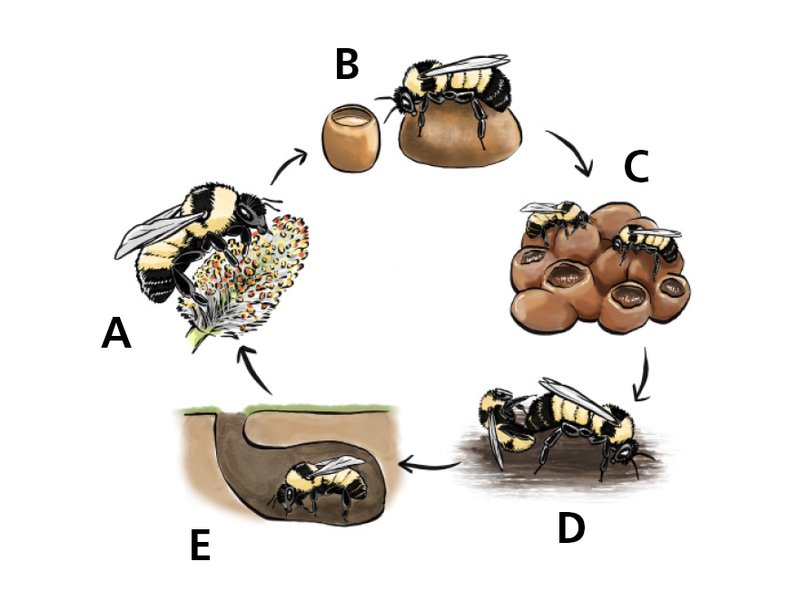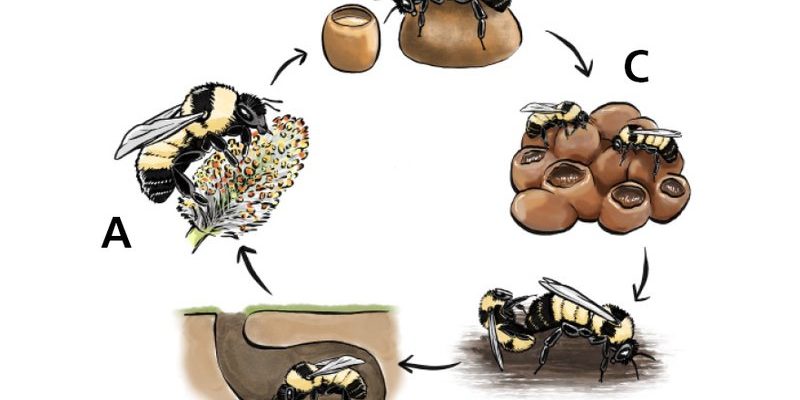
Just imagine a bumblebee’s progression as a series of stages, much like a movie plot. There’s the beginning, middle, and climax—each phase plays a crucial role in shaping who the bee becomes. In this article, we’ll dissect the stages of a bumblebee’s life, from its humble beginnings as an egg all the way to its colorful adulthood. So, grab your favorite cup of coffee, and let’s dive into the world of bumblebees!
The Stages of Bumblebee Development
Bumblebees undergo a specific series of stages known as complete metamorphosis. This means they start as eggs, then hatch into larvae, pupate into cocoons, and finally emerge as adult bees. Each stage is essential and has its own unique characteristics and responsibilities.
- Egg
- Larva
- Pupa
- Adult
Let’s break these down further.
Stage 1: The Bumblebee Egg
Everything begins when the queen bumblebee lays her eggs. Typically, she does this in a cozy nest, often in abandoned rodent burrows or under the ground, where it’s protected from the elements. Each egg is tiny, resembling a grain of rice, and the queen lays several at a time, usually around 5 to 20 eggs in a single batch.
Here’s the interesting part—these eggs are fertilized, meaning that they contain the genetic material needed to develop into new bees. After about 3 to 4 days, the eggs hatch into larvae. Think of this stage as the initial setup for a new life—everything is quiet and still, but there’s a lot happening beneath the surface.
Stage 2: The Bumblebee Larva
Once the eggs hatch, the larvae hatch into small, whitish, caterpillar-like creatures. They are often referred to as “larvae” and are quite hungry. They rely on the worker bees to feed them. The workers bring back nectar and pollen to the nest, where they feed the larvae.
During this stage, the larvae grow rapidly. They eat and eat, shedding their skin several times, similar to how we outgrow our clothes as kids. This formative period lasts around two weeks. It’s almost like a bee boot camp, where they bulk up and prepare for the next phase of their life cycle.
Stage 3: The Pupa Stage
After about two weeks, when the larvae are ready, they enter the pupal stage. This is a really cool transformation. The larvae spin a cocoon around themselves and essentially enter a sleep-like state. Inside that cocoon, they undergo a remarkable change—think of it as a caterpillar transforming into a butterfly, but in this case, it’s a bee coming forth.
The pupal stage lasts about 1 to 2 weeks. During this time, the bee’s body develops all the necessary features of its adult form. You might wonder how it all happens. Well, the larvae’s body breaks down, and new structures form, like wings, legs, and all the parts needed for adult life. It’s a bit like magic, really.
Stage 4: Emerging as an Adult Bumblebee
After about three weeks from the time the queen laid her eggs, the adult bee finally breaks free from its cocoon. Initially, they are soft and crumpled, but they quickly pump blood into their wings and body, expanding and hardening. This is where the bumblebee truly steps into the spotlight.
But the job isn’t done yet. Newly emerged bees typically spend some time inside the nest to learn their roles. Initially, they take on tasks like cleaning the nest and feeding the next batch of larvae. They will eventually join the ranks of foragers, gathering nectar and pollen.
The Role of the Queen and Workers
In a bumblebee colony, there are mainly three types of bees: the queen, workers, and drones. The queen’s primary job is to lay eggs, while the workers do everything else—caring for the young, foraging for food, and maintaining the nest.
You might be curious about the drones. Their role is solely to mate with the queen. After mating, they don’t hang around. It’s almost like they have one job, and once it’s done, they leave the stage. The social structure of bumblebee colonies is quite fascinating, highlighting teamwork and collaboration.
Why Bumblebee Lifecycles Matter
Understanding the lifecycle of a bumblebee isn’t just for nature lovers; it’s important for everyone. Bumblebees play a huge role in our ecosystem as pollinators. They help plants reproduce by transferring pollen, and without them, many of the foods we enjoy may not exist.
While some pollinators are wind-driven, bumblebees are particularly efficient due to their ability to buzz pollinate. This means they can vibrate their bodies to release pollen from plants, making them superstars in the gardening world. By supporting bumblebee populations through conservation efforts, we ensure our environment remains balanced and vibrant.
How You Can Help Bumblebees Thrive
Now that you know about the lifecycle of a bumblebee, you may be wondering how you can contribute to their survival. Here are a few simple steps:
- Plant Native Flowers: Choose plants that bloom at different times throughout the year to provide food for bees.
- Avoid Pesticides: Limit the use of harmful chemicals in your garden to protect bee populations.
- Provide Nesting Sites: Leave patches of bare ground or create bee hotels to encourage nesting.
There’s something truly rewarding about helping these little creatures. By creating a bee-friendly environment, you tie yourself into the web of nature, and it feels pretty amazing.
The lifecycle of a bumblebee—from a tiny egg to a buzzing adult—is a remarkable journey filled with transformation and teamwork. These creatures are an essential part of our ecosystem, and understanding their life stages helps us appreciate their role in nature.
So, next time you see a bumblebee flitting from flower to flower, remember the incredible journey it undertook to get there. Each buzz is a testament to the wonders of life and the importance of protecting these furry little pollinators. By doing our part to nurture their habitats, we contribute to a healthier planet for everyone. And honestly, that’s something we all can feel good about.

